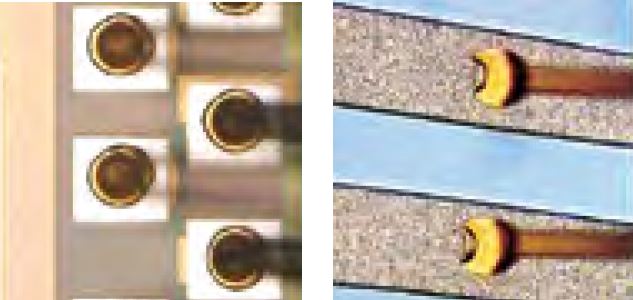SI Capillary
Enhanced Stitch Bondability for Gold & Silver Alloy Wire Bonding
2N9 Au Wire Bonding
The use of 2N9 Alloyed Au wire is becoming popular for fine-pitch and ultra-fine pitch bonding. These wires consist of 99% Au purity with 1% Pd and are formulated with dopant to enhance the looping capability and ball bond reliability. However, these wires are generally harder and more prone to wire breakage and non-sticking problem during stitch bond formation resulting in higher yield loss during production, especially for leaded devices. The nature of the lead frame design with certain degree of bouncing effect during bonding further complicates the robustness of the bonding process.
The challenge is to be able to improve the stitch bondability for 2N Alloyed Au wire. The Stitch Integrator capillary helps to improve the bonding performance as shown in the following application.
Key Notes
-
The enhanced coupling effect between the SI capillary and the alloyed wire has proven to improve the bondability of the stitch bond with minimum interruption to the bonder.
-
At 600K bonds, the load-up condition on the capillary is satisfactory with no excessive load-up accumulation at the tip of the capillary.
-
Destructive test performed through wire pull @ 1/3 wire length did not reveal any abnormality with the stitch bonds as all the wires break @ neck location. This indicates that the stitch bond adhesion is satisfactory with no bond reliability issue. Sample size = 1500 wires.
-
Bonder stoppages due to wire open and short tail defect rate were recorded at less than 1000ppm while regular bonder stoppages was encountered with non-SI capillary.
Challenging Substrates
The pressure to reduce the cost of products has indirectly instilled certain elements of inconsistency to the lead frame and substrate materials, which directly affect the bond reliability of the stitch bonds. Inconsistent lead frame and substrate quality often results in NSOL, short tail or low stitch pull readings during wire bond. Most of the time, the problem is only known after die attach and during wire bond.
The challenge is to be able to improve the stitch bondability for these types of lead frames/substrates. The Stitch Integrator capillary helps to improve the bonding performance as shown in the following application.
Key Notes
-
Destructive test for both ball shear and wire pull has shown that the bondability for the ball and stitch bonds was within the manufacturing specification with good Cpk control.
-
Visually, the ball and stitch bonds at 800K bonds did not show any symptoms of golf ball, irregular ball squashed out or damaged stitch bonds.
-
Bonder stoppages throughout the tool life of the SI capillary was recorded at, NSOL: 614ppm, short tail: 512ppm. No EFO open was encountered.
-
During the O/S test, device failure bonded using the SI capillary showed a substantial reduction in ppm as compared to non-SI capillary on the same device type. Overall, the SI capillary showed an improvement of more than 70% with reduced second bond failure. This indicates that the stitch bondability has improved using the SI capillary.
Do you have additional questions regarding our SI Type?
No worries, we are here to support you. Please send your request by clicking on the button below. Thank you very much.
Do you need additional Tools?
No worries, we have a huge download repository that includes any Information that you looking for!






